

Education
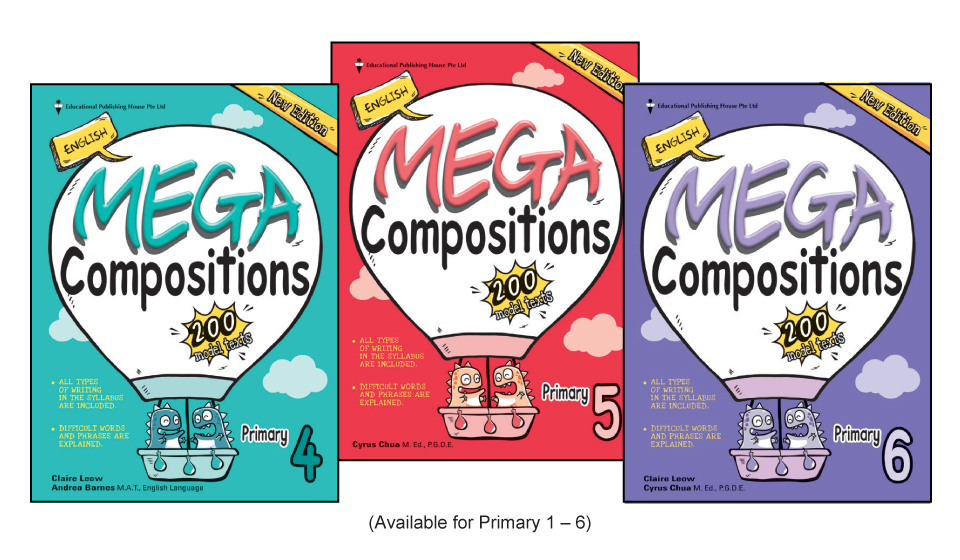
Cultivating a Passion for READING & WRITING
Getting in the groove of reading a book or penning a story can be as easy as one-two-three.
Mar 2024 | By EPH Editorial Team
Getting in the groove of reading a book or penning a story can be as easy as one-two-three.
Mar 2024 | By EPH Editorial Team
In today’s digital age, we do not read and write as much as before because a lot of us spend more time on our mobile devices watching multimedia content and playing games instead. Writing compositions in school can then feel like a chore as we fall out of practice. To reignite and nurture your interest in reading and writing, here are some suggestions.
1 Make Time to Read
Reading and writing go together. Reading sparks your imagination, creativity, and critical and analytical skills, which are the key ingredients to writing. To develop a reading habit, set aside some time to read every day. You can start small. For instance, just 15 minutes a day can be the start of a wonderful habit. Making time to read before bed can help you to relax and sleep better.
2 Read Quality Materials
A good book draws you in and makes it hard for you to stop reading. If you’ve yet to stumble upon a book that you truly like, try expanding your selection of reading materials. Find out what suits your tastes by exploring different genres. Whet your reading appetite by choosing books with interesting settings, plots, or characters. You can also read different text types to expand your vocabulary and pick up various comprehension strategies.
3 Make Time to Write
To improve as a writer, you simply need to keep trying, learning, and writing along the way. An easy way to go about this is to start off by writing about things that interest you or you feel passionate about, like your favourite sport, pop star, or book. You can also keep a journal to pen your innermost thoughts or reflections. Express your true voice by writing and you’ll naturally write more over time.
For more inspiration to get your writing juices flowing, check out the new edition of the English Mega Compositions series ($10.90 each), published by Educational Publishing House (EPH). Each book features an extensive collection of 200 compositions of different text types. This series fosters a love for reading and offers inspiring ideas for your own writing.
Reading and writing go together. Reading sparks your imagination, creativity, and critical and analytical skills, which are the key ingredients to writing. To develop a reading habit, set aside some time to read every day. You can start small. For instance, just 15 minutes a day can be the start of a wonderful habit. Making time to read before bed can help you to relax and sleep better.
2 Read Quality Materials
A good book draws you in and makes it hard for you to stop reading. If you’ve yet to stumble upon a book that you truly like, try expanding your selection of reading materials. Find out what suits your tastes by exploring different genres. Whet your reading appetite by choosing books with interesting settings, plots, or characters. You can also read different text types to expand your vocabulary and pick up various comprehension strategies.
3 Make Time to Write
To improve as a writer, you simply need to keep trying, learning, and writing along the way. An easy way to go about this is to start off by writing about things that interest you or you feel passionate about, like your favourite sport, pop star, or book. You can also keep a journal to pen your innermost thoughts or reflections. Express your true voice by writing and you’ll naturally write more over time.
For more inspiration to get your writing juices flowing, check out the new edition of the English Mega Compositions series ($10.90 each), published by Educational Publishing House (EPH). Each book features an extensive collection of 200 compositions of different text types. This series fosters a love for reading and offers inspiring ideas for your own writing.
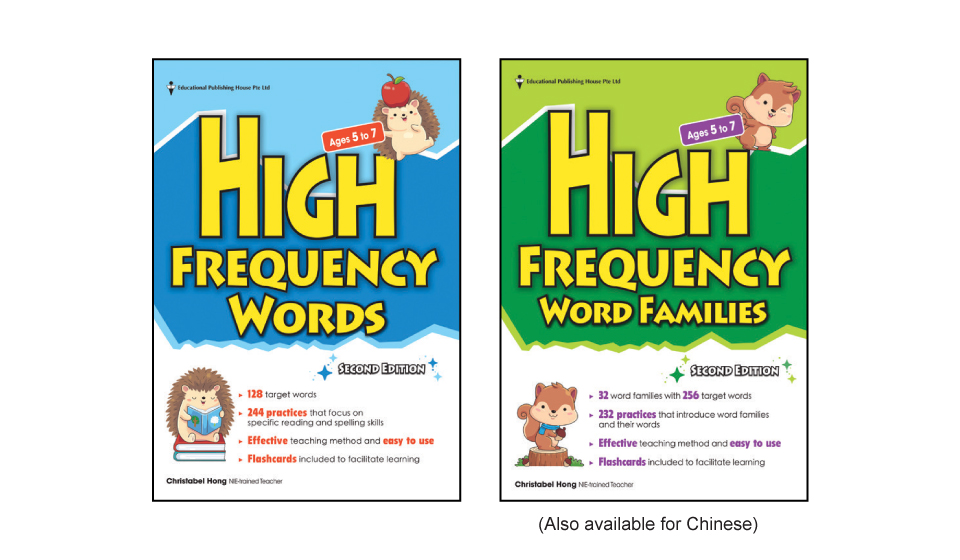
HIGH-FREQUENCY WORDS for Preschool Learning
Here’s how to incorporate high-frequency words in your tot’s daily routine to maximise preschool language learning.
Nov 2023 | By EPH Editorial Team
Here’s how to incorporate high-frequency words in your tot’s daily routine to maximise preschool language learning.
Nov 2023 | By EPH Editorial Team
As parents, you hold the key to your child’s early language development. Did you know
that introducing high-frequency words — words that appear often in everyday reading and writing — during preschool years can greatly boost your child’s language skills? Here are five effective tips to help you maximise your preschooler’s language learning using high-frequency words.
1 Make Learning Fun
Learning doesn’t have to feel like a chore. Incorporate high-frequency words into games and activities your child already loves. Use flashcards and play ‘I Spy’ using high-frequency words instead of objects. These methods turn learning into a playful adventure, keeping your child engaged and excited.
2 Create a Word-Rich Environment
Surround your child with words! Label everyday items around the house (e.g. mug, pot, mat) using sticky notes or removable tape. When they see these words often, paired with high-frequency words, they’ll start recognising and remembering them naturally.
3 Read Together
Reading is a powerful tool for language development. Choose books that feature high-frequency words and read aloud together. Encourage your child to point at the words as you read them. Repetition is key! The more your child hears and sees these words, the more they’ll understand and use them.
4 Sing and Rhyme
Children love music and rhymes. Incorporate high-frequency words into catchy songs and rhymes. Create your own tunes or find existing ones online. When words are set to music, they become even more memorable. You’ll be amazed at how quickly your child picks up these words through rhythm and melody.
5 Converse Daily
Simple daily conversations provide countless opportunities to introduce high-frequency words. Talk to your child about their day, activities, and surroundings. Use these words naturally in sentences, for instance, “Put on your cap before going outside.” Contextual use helps your child grasp the meaning and usage of these words.
To complement the above, introduce your child to activity books that are both enjoyable and feature effective teaching methods. Adored by parents and teachers alike, the new 2nd edition of the High Frequency Words series ($12.90 each) from Educational Publishing House serves as a reliable companion for your child’s language development. Equipped with ample practices and flashcards, these easy-to-use books will empower your child to become better readers!
Remember, every child learns at their own pace. Celebrate their progress and efforts along the way. By incorporating high-frequency words into their daily routine, you’re building a solid foundation for your child’s language skills as they grow.
Learning doesn’t have to feel like a chore. Incorporate high-frequency words into games and activities your child already loves. Use flashcards and play ‘I Spy’ using high-frequency words instead of objects. These methods turn learning into a playful adventure, keeping your child engaged and excited.
2 Create a Word-Rich Environment
Surround your child with words! Label everyday items around the house (e.g. mug, pot, mat) using sticky notes or removable tape. When they see these words often, paired with high-frequency words, they’ll start recognising and remembering them naturally.
3 Read Together
Reading is a powerful tool for language development. Choose books that feature high-frequency words and read aloud together. Encourage your child to point at the words as you read them. Repetition is key! The more your child hears and sees these words, the more they’ll understand and use them.
4 Sing and Rhyme
Children love music and rhymes. Incorporate high-frequency words into catchy songs and rhymes. Create your own tunes or find existing ones online. When words are set to music, they become even more memorable. You’ll be amazed at how quickly your child picks up these words through rhythm and melody.
5 Converse Daily
Simple daily conversations provide countless opportunities to introduce high-frequency words. Talk to your child about their day, activities, and surroundings. Use these words naturally in sentences, for instance, “Put on your cap before going outside.” Contextual use helps your child grasp the meaning and usage of these words.
To complement the above, introduce your child to activity books that are both enjoyable and feature effective teaching methods. Adored by parents and teachers alike, the new 2nd edition of the High Frequency Words series ($12.90 each) from Educational Publishing House serves as a reliable companion for your child’s language development. Equipped with ample practices and flashcards, these easy-to-use books will empower your child to become better readers!
Remember, every child learns at their own pace. Celebrate their progress and efforts along the way. By incorporating high-frequency words into their daily routine, you’re building a solid foundation for your child’s language skills as they grow.

New 2024 Primary 1 CHINESE SYLLABUS
How does this new syllabus compare with the old one?
Mar 2024 | By EPH Editorial Team
How does this new syllabus compare with the old one?
Mar 2024 | By EPH Editorial Team
2024 sees a new Primary 1 Chinese syllabus being introduced, with《欢乐伙伴2.0》adjusted and modified based on the 2015 Chinese textbook《欢乐伙伴》. Several major changes are reflected in the new Primary 1 Chinese Syllabus, which we have highlighted in the table below.
| Old Syllabus 欢乐伙伴 |
New Syllabus 欢乐伙伴2.0 |
|
| Topic Sequence 课文顺序 |
Unit 1: 我上学了 Unit 2: 我家有九个人 Unit 3: 今天是我的生日 Unit 4: 我喜欢打篮球 Unit 5: 现在几点 Unit 10: 课室里有什么 |
Changes to the 识读字 and 识写字 introduced per unit; additional 识写字 are also introduced. |
| Unit 6: 我感冒了 Unit 7: 这是我的学校 Unit 8: 今天有体育课吗 Unit 9: 我的东西不见了 |
Changes to topic sequence, with a new set of 识读字 and 识写字 under each unit: Unit 6: 这是我的学校 Unit 7: 我的东西不见了 Unit 8: 我感冒了 Unit 9: 今天有体育课吗 |
| Old Syllabus 欢乐伙伴 |
New Syllabus 欢乐伙伴2.0 |
|
| Hanyu Pinyin Sequence 汉语拼音顺序 |
Unit 2: b p m f d t n l Unit 3: g k h j q x Unit 4: zh ch sh r z c s Unit 5: ai ao an ang |
No change |
| Unit 1: a o e i u v Unit 6: ou ong Unit 7: ei en eng er Unit 8: ia iao iang ie ian iu iong in ing Unit 9: ua uo ui un uai uan uang Unit 10: ve vn van |
Changes to Hanyu Pinyin under each unit: Unit 1: ‘er’ is added on top of the existing vowels Unit 6: ia iao ian iang ie Unit 7: ua uo uai uan uang Unit 8: ou ong ei eng Unit 9: iu in ing iong Unit 10: ui un ve vn van |
The new syllabus uses a multimodal approach to help pupils learn Chinese. This approach sees technology being integrated into the learning process, which encourages interactive reading and independent learning outside of school settings. To supplement your child’s learning, you may refer to several assessment books that are aligned to the new syllabus from Educational Publishing House, which include e-learning resources such as classroom-simulated audio for Listening Comprehension practices.
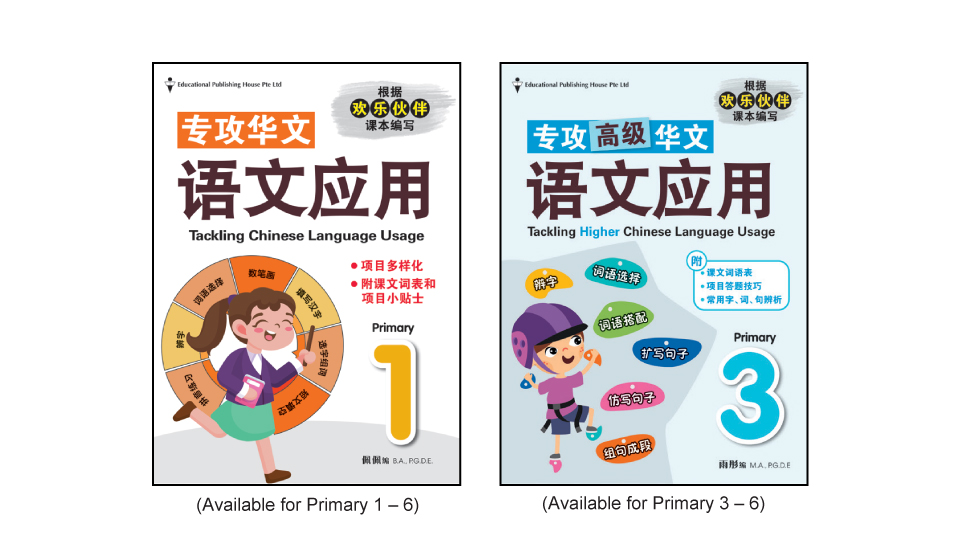
SCORE IN PRIMARY CHINESE Language Usage
Let’s hear from experienced teachers on how to do well in Chinese Language Usage.
Nov 2023 | By EPH Editorial Team
Let’s hear from experienced teachers on how to do well in Chinese Language Usage.
Nov 2023 | By EPH Editorial Team
Language Usage is a component tested in the Primary Chinese examination. With adequate practice and good preparation, pupils can score well for the component. Experienced teachers 刘璐滢老师, 佩佩老师 and 雨彤老师, authors of Tackling Chinese Language Usage ($10.90) and Tackling Higher Chinese Language Usage ($10.90), share with us some tips to excel in this
component.
Q
Why is it important to build a strong foundation in Chinese Language Usage?
刘老师: Questions testing pupils’ language usage skills have a rather high weightage in Chinese/ Higher Chinese Language Paper 2. Pupils’ overall grades will be pulled up if they are able to apply appropriate skills to derive the correct answer. A good grasp of language usage skills is also helpful when attempting comprehension questions as pupils will be able to better understand the passage and recognise what should be included in their answers.
Q How can parents and teachers support and encourage pupils in their learning of Chinese to boost language usage at home and in school?
佩佩老师: Parents can encourage their children to watch news reported in Chinese, read Chinese storybooks, and listen to Chinese songs. Parents can also model good Chinese language usage at home by communicating with each other in Chinese.
刘老师: Teachers can assign suitable reading tasks and practices to build a strong foundation and allow in-depth learning. Teachers can also provide timely feedback to pupils so that they are aware of their mistakes and areas for improvement.
Q Do you have any tips to score well in the Chinese Language Usage component?
雨彤老师: Practice makes perfect. Familiarising yourself with the vocabulary, questions, and examination format plays an integral part in scoring well.
刘老师: Revising the syllabus words is also important. Other than that, remember PUMPS:
P: Remember the Pinyin
U: Understand and differentiate the tested word(s) from similar ones
M: Remember the Meaning
P: Pair the word(s) with commonly associated words
S: Form Sentences using the word(s)
Q How does Tackling Chinese/ Higher Chinese Language Usage help pupils with examination preparation?
佩佩老师, 刘老师 & 雨彤老师: This series by Educational Publishing House is crafted based on the latest MOE curriculum and is closely aligned with current examination topics and question formats. It also offers effective answering strategies and revision word lists to help pupils tackle the examinations with confidence.
刘老师: Questions testing pupils’ language usage skills have a rather high weightage in Chinese/ Higher Chinese Language Paper 2. Pupils’ overall grades will be pulled up if they are able to apply appropriate skills to derive the correct answer. A good grasp of language usage skills is also helpful when attempting comprehension questions as pupils will be able to better understand the passage and recognise what should be included in their answers.
Q How can parents and teachers support and encourage pupils in their learning of Chinese to boost language usage at home and in school?
佩佩老师: Parents can encourage their children to watch news reported in Chinese, read Chinese storybooks, and listen to Chinese songs. Parents can also model good Chinese language usage at home by communicating with each other in Chinese.
刘老师: Teachers can assign suitable reading tasks and practices to build a strong foundation and allow in-depth learning. Teachers can also provide timely feedback to pupils so that they are aware of their mistakes and areas for improvement.
Q Do you have any tips to score well in the Chinese Language Usage component?
雨彤老师: Practice makes perfect. Familiarising yourself with the vocabulary, questions, and examination format plays an integral part in scoring well.
刘老师: Revising the syllabus words is also important. Other than that, remember PUMPS:
P: Remember the Pinyin
U: Understand and differentiate the tested word(s) from similar ones
M: Remember the Meaning
P: Pair the word(s) with commonly associated words
S: Form Sentences using the word(s)
Q How does Tackling Chinese/ Higher Chinese Language Usage help pupils with examination preparation?
佩佩老师, 刘老师 & 雨彤老师: This series by Educational Publishing House is crafted based on the latest MOE curriculum and is closely aligned with current examination topics and question formats. It also offers effective answering strategies and revision word lists to help pupils tackle the examinations with confidence.

Four-Step Blueprint to ACING SCIENCE EXAMS
Here are four useful study tips to put you on the path to acing your science exams.
Mar 2024 | By Sandy Ng, co-author of P3 Daily Dose of Science
Here are four useful study tips to put you on the path to acing your science exams.
Mar 2024 | By Sandy Ng, co-author of P3 Daily Dose of Science
Success in science exams requires a combination of good knowledge of concepts,
sufficient preparation, strategic thinking, and a strong dose of tenacity. Use the following four steps to prepare, perform better, and handle the challenges of your exams with renewed confidence.
1 Consistent Revision
There is no shortcut to becoming familiar with concepts. Consistent revision boosts retention, builds foundation, and improves understanding and application of concepts. Make it a point to consolidate and review knowledge learned in class daily and you’ll get into the good habit of doing so in no time.
2 Memorise Standard Answers
We all need help to get started. Memorising standard answers allows you to quickly recall information so that your answers are precise and coherent in the exams. Standard answers are the foundation on which you apply scientific concepts based on the different contexts given. You can then further modify these answers in your own words. Make your own summary sheets and flashcards of standard answers and rope in your parents, siblings, and friends to test you regularly.
3 Practise Different Types of Questions
Attempt past-year exam papers and assessment books regularly, as they provide a wide array of inquiry-based questions where you can hone your understanding of scientific concepts. You will also become more familiar with the exam format, types of questions asked, and recurring themes in the process.
4 Self-Imposed Time Limit
When you adopt a self-imposed time limit in your practices, you learn to allocate time more wisely and ensure all questions are given sufficient thought. This approach also develops your ability to think under pressure, especially when tackling challenging questions which require careful consideration. The general recommendation is to allocate 45 minutes for Section A and 1 hour for Section B. Start with more flexible time intervals and gradually work towards the suggested duration once you get the hang of it. If you need a visual reminder to keep track of time, place a clock in front of you as you work.
Academic progress takes dedication and proactiveness. Commit yourself to the four steps above and your efforts will certainly pay off in your exams. To supplement your revision, you may also utilise the Daily Dose of Science series ($17.90 each) as a daily review companion. This series provides a good range of questions based on real-world applications and comes with suggested answers and explanations to cater for self-directed learning.
There is no shortcut to becoming familiar with concepts. Consistent revision boosts retention, builds foundation, and improves understanding and application of concepts. Make it a point to consolidate and review knowledge learned in class daily and you’ll get into the good habit of doing so in no time.
2 Memorise Standard Answers
We all need help to get started. Memorising standard answers allows you to quickly recall information so that your answers are precise and coherent in the exams. Standard answers are the foundation on which you apply scientific concepts based on the different contexts given. You can then further modify these answers in your own words. Make your own summary sheets and flashcards of standard answers and rope in your parents, siblings, and friends to test you regularly.
3 Practise Different Types of Questions
Attempt past-year exam papers and assessment books regularly, as they provide a wide array of inquiry-based questions where you can hone your understanding of scientific concepts. You will also become more familiar with the exam format, types of questions asked, and recurring themes in the process.
4 Self-Imposed Time Limit
When you adopt a self-imposed time limit in your practices, you learn to allocate time more wisely and ensure all questions are given sufficient thought. This approach also develops your ability to think under pressure, especially when tackling challenging questions which require careful consideration. The general recommendation is to allocate 45 minutes for Section A and 1 hour for Section B. Start with more flexible time intervals and gradually work towards the suggested duration once you get the hang of it. If you need a visual reminder to keep track of time, place a clock in front of you as you work.
Academic progress takes dedication and proactiveness. Commit yourself to the four steps above and your efforts will certainly pay off in your exams. To supplement your revision, you may also utilise the Daily Dose of Science series ($17.90 each) as a daily review companion. This series provides a good range of questions based on real-world applications and comes with suggested answers and explanations to cater for self-directed learning.

2024 O-LEVEL PURE BIOLOGY Examination Structure
What’s in store for the new O-Level Pure Biology examination next year?
Nov 2023 | By EPH Editorial Team
What’s in store for the new O-Level Pure Biology examination next year?
Nov 2023 | By EPH Editorial Team
As 2023 draws to a close, it also marks the end of the present O-Level Science syllabuses. Soon-to-be Secondary 4 students may wonder: how will the
2024 O-Level Science examinations differ from the ones their seniors sat for? In the Mar/Apr 2023 issue, the changes to the syllabuses were discussed. In this issue, let’s explore the changes to the examination structure, specifically for Pure Biology.
For Pure Biology, the number of papers will remain the same — three altogether. The duration, total marks, and overall weighting will remain the same too. Here is the breakdown:
| COMPONENT | MARKS | DURATION | OVERALL WEIGHTING (%) |
| Paper 1: Multiple-choice Questions | 40 | 1 hour | 30 |
| Paper 2: Structured and Free-response Questions | 80 | 1 hour 45 minutes | 50 |
| Paper 3: Practical Questions | 40 | 1 hour 50 minutes | 20 |
No Changes to Structure: Papers 1 and 3
There will be 40 compulsory multiple-choice questions in Paper 1. As the duration will only be an hour, students are advised to spend no more than 1.5 minutes on each question. Also, as there will be no penalty for wrong answers, students are advised to attempt all questions even if they are unsure of the correct answer.
For Paper 3, there will be two to three compulsory questions, each with various parts. While some sections of the syllabus may not have experiments that are feasible within the duration of the paper or constraints of the school’s laboratory inventory, questions on these may still be tested. For example, students may be asked to plan the experiment without actually carrying it out and such questions may be worth up to 5 marks.
Changes to Structure: Paper 2
For Paper 2, while there will still be two sections (A and B), the marks distribution will differ from the present marking scheme. Section A will carry 70 marks (an increase from the present 50 marks) and Section B will carry 10 marks (a decrease from the present 30 marks).
All questions in Section A will be compulsory, including one free-response question and one data-based question as the last two questions. Section B will offer students a choice of one out of two free-response questions to answer. As these data-based and free-response questions may be challenging, students are encouraged to practise diligently with assessment books such as O Level (G3) Fast Forward Biology ($19.90) from Educational Publishing House to instil confidence for the examination.
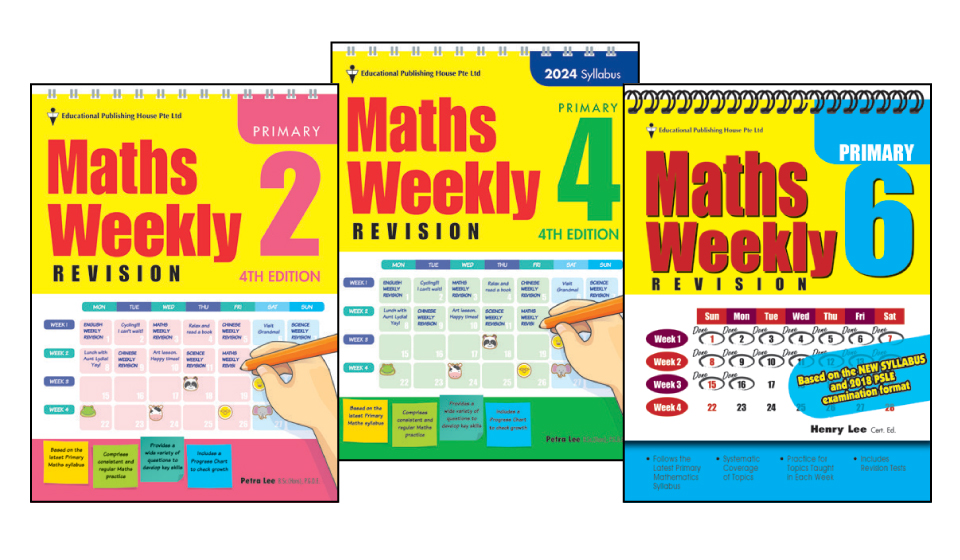
CONSISTENT PRACTICE in Maths
Author Petra Lee shares her thoughts on her bestselling assessment series, Maths Weekly Revision.
Mar 2024 | By EPH Editorial Team
Author Petra Lee shares her thoughts on her bestselling assessment series, Maths Weekly Revision.
Mar 2024 | By EPH Editorial Team
Driven by her passion for shaping young minds, Petra Lee transitioned from real estate to teaching and was a former MOE Primary School teacher of nearly 20 years. Influenced greatly by her father’s teaching legacy, she advocates for the ethos of consistent practice and is dedicated to nurturing young learners. The EPH Editorial Team speaks with her to find out what went into the making of her bestselling series, Maths Weekly Revision ($11.50 – $11.90).
Q What motivated you to write this series?
The genesis of this series traces back to my late father, the visionary behind its inception. During his time spent teaching in a primary school, my father wanted to help his pupils achieve mastery of the mathematical concepts taught in school, regardless of their learning abilities. However, some pupils fell behind, thus he decided to devote time to revisit previously taught concepts and ensure his pupils were dutifully practising maths questions. Seeing the improvement made by many of his pupils over time, my father witnessed first-hand the importance of consistent practice. Inheriting my father’s steadfast belief in the power of consistent practice, I’ve carried forward his teachings into my own role as an educator. My father and I believed that an assessment series that embraced the values of discipline in consistent practice would serve as the building blocks towards success in maths. Thus, the Maths Weekly Revision series was born.
Q Where did you get the inspiration or ideas for this series?
The fundamental principle which guides us in writing this series is consistent practice as a catalyst for mastery in maths. We draw inspiration and ideas from our classrooms, and try to conceptualise what works for our pupils and put what was practised in class on paper. For instance, pupils who struggle with basic operations like multiplication inspired us to design creative and engaging multiplication booklets. Through consistent practice sessions, they were eventually able to master the multiplication tables while having fun learning.
Q Why is consistent practice important in maths?
Consistent practice allows pupils to solidify their understanding and achieve deeper mastery of concepts. It cultivates a deeper retention of knowledge and enables pupils to navigate complex mathematical problems with confidence.
Q How can this series help pupils excel in maths?
The Maths Weekly Revision series aids pupils in excelling in maths by providing structured and regular practice materials. Inspired by successful classroom strategies, it reinforces key concepts and encourages self-directed learning. This approach helps build a strong foundation, prepares pupils for assessments, and makes maths more engaging and enjoyable.
The genesis of this series traces back to my late father, the visionary behind its inception. During his time spent teaching in a primary school, my father wanted to help his pupils achieve mastery of the mathematical concepts taught in school, regardless of their learning abilities. However, some pupils fell behind, thus he decided to devote time to revisit previously taught concepts and ensure his pupils were dutifully practising maths questions. Seeing the improvement made by many of his pupils over time, my father witnessed first-hand the importance of consistent practice. Inheriting my father’s steadfast belief in the power of consistent practice, I’ve carried forward his teachings into my own role as an educator. My father and I believed that an assessment series that embraced the values of discipline in consistent practice would serve as the building blocks towards success in maths. Thus, the Maths Weekly Revision series was born.
Q Where did you get the inspiration or ideas for this series?
The fundamental principle which guides us in writing this series is consistent practice as a catalyst for mastery in maths. We draw inspiration and ideas from our classrooms, and try to conceptualise what works for our pupils and put what was practised in class on paper. For instance, pupils who struggle with basic operations like multiplication inspired us to design creative and engaging multiplication booklets. Through consistent practice sessions, they were eventually able to master the multiplication tables while having fun learning.
Q Why is consistent practice important in maths?
Consistent practice allows pupils to solidify their understanding and achieve deeper mastery of concepts. It cultivates a deeper retention of knowledge and enables pupils to navigate complex mathematical problems with confidence.
Q How can this series help pupils excel in maths?
The Maths Weekly Revision series aids pupils in excelling in maths by providing structured and regular practice materials. Inspired by successful classroom strategies, it reinforces key concepts and encourages self-directed learning. This approach helps build a strong foundation, prepares pupils for assessments, and makes maths more engaging and enjoyable.
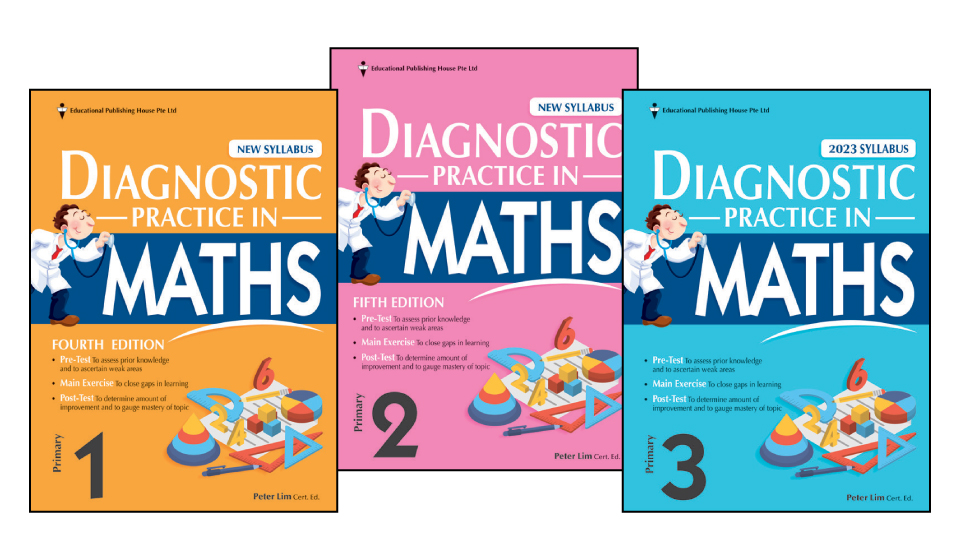
Primary Maths DIAGNOSTIC ASSESSMENT
Here’s a handy evaluative tool to help gauge and track your child’s academic progress.
Nov 2023 | By EPH Editorial Team
Here’s a handy evaluative tool to help gauge and track your child’s academic progress.
Nov 2023 | By EPH Editorial Team
Q What is diagnostic assessment?
Diagnostic assessment is a type of formative assessment designed to gather information about how pupils perform in a particular topic. Usually, a pre-evaluation is given at the start of a lesson and/or a post-evaluation is given at the end of it. The pre-evaluation allows pupils to discover how much prior knowledge they possess about the topic while the post-evaluation shows how much improvement they have made over the course of the lesson.
Diagnostic assessment is a type of formative assessment designed to gather information about how pupils perform in a particular topic. Usually, a pre-evaluation is given at the start of a lesson and/or a post-evaluation is given at the end of it. The pre-evaluation allows pupils to discover how much prior knowledge they possess about the topic while the post-evaluation shows how much improvement they have made over the course of the lesson.
Q Why is diagnostic assessment important?
Diagnostic assessment is an essential tool to understand a pupil’s strengths and weaknesses. It is used to gauge pupils’ levels of knowledge and allow them to become aware of their own learning gaps. This is particularly important as pupils must be able to pinpoint and work on their areas of weakness early to avoid falling behind. In addition, diagnostic assessment also helps teachers and parents determine how best to address the specific learning needs of each child.
Q How does diagnostic assessment help your child in Primary Maths?
Diagnostic assessment is useful to identify specific maths topics, concepts, or application methods your child may face learning difficulties in. It can be administered at home or during maths lessons, and feedback can be given almost instantaneously so your child can learn from their mistakes straightaway. For upper primary pupils who can assess themselves, self-administered diagnostic assessment can encourage independent learning and motivate them in their revision as they strive to do better with every assessment. Furthermore, as diagnostic assessments are mostly informal and not used for formal grading purposes, your child can avoid the anxiety of formal assessments and enjoy a positive learning experience at the same time. To evaluate your child’s understanding and application of mathematical concepts, refer to P1 – P3 Diagnostic Practice in Maths ($12.90 each) by Educational Publishing House. This series consists of a pre-test, a main exercise, and a post-test for each topic to fulfil the learning needs of your child at their own pace.
Diagnostic assessment is an essential tool to understand a pupil’s strengths and weaknesses. It is used to gauge pupils’ levels of knowledge and allow them to become aware of their own learning gaps. This is particularly important as pupils must be able to pinpoint and work on their areas of weakness early to avoid falling behind. In addition, diagnostic assessment also helps teachers and parents determine how best to address the specific learning needs of each child.
Q How does diagnostic assessment help your child in Primary Maths?
Diagnostic assessment is useful to identify specific maths topics, concepts, or application methods your child may face learning difficulties in. It can be administered at home or during maths lessons, and feedback can be given almost instantaneously so your child can learn from their mistakes straightaway. For upper primary pupils who can assess themselves, self-administered diagnostic assessment can encourage independent learning and motivate them in their revision as they strive to do better with every assessment. Furthermore, as diagnostic assessments are mostly informal and not used for formal grading purposes, your child can avoid the anxiety of formal assessments and enjoy a positive learning experience at the same time. To evaluate your child’s understanding and application of mathematical concepts, refer to P1 – P3 Diagnostic Practice in Maths ($12.90 each) by Educational Publishing House. This series consists of a pre-test, a main exercise, and a post-test for each topic to fulfil the learning needs of your child at their own pace.